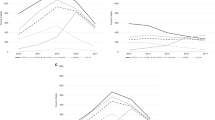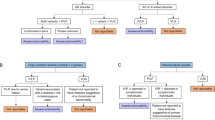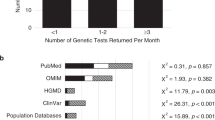Abstract
Purpose: Duplicate genetic testing (DGT) should give the same results as the initial genetic test. Therefore, DGT is indicated only in the rare instances where the initial results require confirmation. The objective of this study was to determine the incidence of DGT by reviewing TPMT, HFE, and CYP450 2D6 polymorphism testing performed in our institution's laboratories in 2006. A secondary objective was to determine the savings in charges that resulted from a system in place to limit HFE DGT.
Methods: A retrospective records review at an academic medical center.
Results: The percentage of patients having the same genetic test more than once in 2006 was 3.3% (253/7710) for TPMT, 0.3% for HFE (24/7851), and 0.9% (4/433) for CYP450 2D6 testing. Retail laboratory charges for the DGT identified in 2006 were $76,728. To estimate the incidence of DGT over a longer period of time than 2006, an all-time records review was performed on a subset of internal patients and found the all-time incidence of DGT for TPMT, HFE, and CYP450 2D6 testing to be 6.9%, 1.9%, and 0.9%, respectively. No case of DGT with an appropriate indication for duplicate testing was found. A system in place to decrease HFE DGT is estimated to have saved $77,479 in charges for 2006 (95% CI, $35,512–184,015).
Conclusions: Indicated DGT is rare and decreasing DGT could result in significant savings. Institutions should consider implementing a systems-based process to limit DGT.
Similar content being viewed by others
Main
Most genetic testing uses DNA extracted from peripheral blood lymphocytes. DNA extracted from these cells rarely changes during a person's lifetime, and a duplicate genetic test should give the same the results as the initial test. Therefore, duplicate genetic testing (DGT) is indicated only in the rare circumstances where the initial results require confirmation. Examples of appropriate indications for DGT include concern for switching of samples or when genetic testing results are unexpected and require confirmation.
This is the first study of the incidence of DGT, specifically the incidence of duplicate HFE, TPMT, and CYP450 2D6 polymorphism genetic testing. Mutations in the HFE gene are associated with the iron overload disorder hemochromatosis.1 The TPMT gene codes for the thiopurine S-methyl transferase enzyme, which is involved in metabolizing the immunosuppressant drug azathioprine. Clinicians use TPMT testing to identify patients who are poor metabolizers of azathioprine metabolites and are at high risk developing aziothioprine-related side effects.2 CYP450 2D6 polymorphisms can predict a patient's response to therapy and the possibility of adverse reactions from antidepressants and other drugs metabolized by the CYP450 2D6 drug metabolism enzyme.3
We reviewed all HFE testing and the majority of TPMT and internally referred CYP450 2D6 testing performed in Mayo Clinic laboratories in 2006 to determine the percentage of patients who had the same genetic test performed more than once in 2006. In addition, to determine the incidence of DGT over a longer period of time, we performed an all-time records review on a subset of consecutive patients from inside our institution that had HFE, TPMT, or CYP450 2D6 testing in 2006.
To investigate whether the type of medical practice (academic vs. community) was associated with an increased incidence of DGT, we compared the incidence of DGT for HFE and TPMT testing in internal and external referral groups. The internal sample cohort consisted of patients seen in our institution's academic medical center practice, while the external sample cohort represented an admixture of samples referred from both academic and community-based practices.
During the time this study was performed, the laboratory performing HFE testing had a system in place to limit HFE DGT. This report also includes the performance of this system and recommendations for the management of DGT.
MATERIALS AND METHODS
Databases of all HFE testing, 84% of TPMT testing (8000/9537), and 49% of internally referred CYP450 2D6 testing (437/884) performed in 2006 by Mayo Clinic laboratories were reviewed for DGT. In addition, consecutive series of patients from inside our institution who had HFE, TPMT, or CYP450 2D6 testing in 2006 underwent further all-time records review for DGT.
HFE, TPMT, and CYP450 2D6 testing was performed in three separate laboratories. HFE testing comprised testing for the C282Y, H63D, and S65C mutations using Lightcycler® technology. TPMT testing was performed using enzymatic end point or liquid chromatography-tandem mass spectrometry. CYP450 2D6 polymorphism testing was performed using allele-specific primer extension or bead hybridization with fluorescence detection. The Mayo Clinic Institutional Review Board approved this study.
RESULTS
Duplicate genetic testing
The percentage of patients having HFE, TPMT, and CYP450 2D6 testing in 2006 who had a duplicate test in 2006 is shown in Table 1.
The most commonly cited reasons for DGT by laboratory personnel and ordering clinicians were lack of time to adequately review records for previous testing, difficulty in accessing records of previous testing, and lack of understanding by the ordering clinician that DGT will give the same results as the initial test.
There was no significant difference in DGT between the internal or external referral cohorts for TPMT and HFE testing (TPMT P = 0.13, HFE P = 0.15, two-tailed P value using Fisher's exact test). We had expected to find a higher rate of DGT in the external referral cohort, as it included samples referred from community practice where physicians were hypothesized to be less adept at genetic testing.
A higher percentage of patients having TPMT testing had duplicate testing than patients having HFE or CYP450 2D6 testing. Many patients had TPMT testing three or more times (Table 2). A possible explanation for this may be that a TPMT test is automatically ordered as part of routine laboratory orders for some physicians subspecializing in autoimmune diseases.
As expected, the all-time records review found a higher rate of DGT than analysis of the 2006 calendar year data alone. Of the 246 patients who had TPMT testing in 2006 included in the all-time records review, 10 had two or more tests in 2006 alone and seven additional patients had one test in 2006 and one or more additional tests at some time earlier than 2006. The all-time DGT rate most probably reflects the true incidence of DGT, but we were only able to determine the all-time rate for internal samples.
For internal patients having DGT, records were reviewed for an appropriate indication for repeating genetic testing. In no case was there documentation of an appropriate indication for DGT. From this, we conclude that appropriately indicated DGT is rare.
System to limit duplicate HFE testing
At the time of this study (2006), the laboratory performing HFE testing had a system in place to limit HFE DGT. During sample accession a technician identified requests for duplicate HFE testing through a computerized search of laboratory records. Duplicate tests continued through standard HFE test processing, while an attempt was made to contact the referring physician. Testing was canceled if the referring physician could be contacted and cancellation confirmed before HFE test completion.
In the consecutive series of 207 internal patients referred for HFE testing, five of nine duplicate test requests were canceled using this protocol. For 2006, this system saved an estimated $77,479 charges for duplicate HFE testing (95% CI, $35,512–184,015). This estimation was calculated by multiplying the percentage of canceled test requests per patient tested (2.4%; 95% CI, 1.1%–5.7%, Wilson procedure) by the total number of patients being tested in 2006 (7851) and the charge for HFE testing.
Laboratory charges associated with DGT
Laboratory charges for DGT identified in the 2006 data set were $76,728. This was calculated using 2006 retail test charges (HFE $411.20, TPMT $289.10, CYP450 2D6 $236.30). As we did not review 16% of TPMT tests and 46% of CYP450 2D6 tests or include DGT occurring outside of the 2006 calendar year data, the true charges associated with DGT in 2006 is higher than our estimate. This estimate also does not include the estimated $77,479 in savings from the system preventing HFE DGT.
DISCUSSION
We found that DGT accounts for a small but measurable percentage of total testing volume for the studied tests. Our results should be generalizable to genetic testing in both academic and community medical practices. These results should also be generalizable to other high volume genetic tests such as Factor V Leiden, PT20210G->A, and cystic fibrosis mutation panel testing.
A body of literature has been published on inappropriate laboratory utilization, and DGT could be classified under this heading. A systematic review of clinical laboratory audits found 5% to 50% of laboratory testing could be classified as inappropriate.4 In the only published study of the appropriateness of a genetic test, 17% of APC tests for familial adenomatous polyposis were found to be requested for inappropriate indications.5 The only previous report of DGT was included in a study of genetic testing in liver transplant patients where seven duplicate genetic tests were identified in a cohort of 215 patients.6
We predict the incidence and costs associated with DGT will grow as the use of genetic testing continues to increase. In addition to limiting unnecessary testing and costs, another reason to limit DGT is that it is a potential source of medical errors. Clinicians may wait to implement needed treatment until the results of the genetic testing they ordered are available, when in fact the results are already available.
Limiting DGT at the laboratory level, as done by the HFE laboratory in this study, has several drawbacks. Even if the test is cancelled in the laboratory the costs of obtaining the sample, shipping, and the system to cancel the DGT remain. Although a laboratory-based system to eliminate DGT may decrease laboratory charges to the client, the cost of implementing such a system is borne by the laboratory. Also, any single laboratory-based system limiting DGT does not prevent DGT through sample submission to a different laboratory. For these reasons, our recommended approach to DGT would be a systems-based approach to limit DGT at the time of test ordering. Ideally, a computerized test order entry system would be able to query laboratory databases and alert the ordering clinician to possible DGT. To our knowledge, such a system is not in operation anywhere. Another more feasible intervention would be increasing the accessibility of previous genetic testing results to ordering clinicians through existing medical records systems.
References
Feder JN, Gnirke A, Thomas W, Tsuchihashi Z, et al. A novel MHC class I-like gene is mutated in patients with hereditary haemochromatosis. Nat Genet 1996; 13: 399–408.
Richard VS, Al-Ismail D, Salamat A . Should we test TPMT enzyme levels before starting azathioprine?. Hematology 2007; 12: 359–360.
Vandel P, Talon JM, Haffen E, Sechter D . Pharmacogenetics and drug therapy in psychiatry—the role of the CYP2D6 polymorphism. Curr Pharm Des 2007; 13: 241–250.
van Walraven C, Naylor CD . Do we know what inappropriate laboratory utilization is? A systemic review of laboratory clinical audits. JAMA 1998; 280: 550–558.
Giardiello FM, Brensinger JD, Petersen GM, Luce MC, et al. The use and interpretation of commercial APC gene testing for familial adenomatous polyposis. N Engl J Med 1997; 336: 823–827.
Riegert-Johnson DL, Macaya D, Hefferon TW, Boardman LA . Medical errors related to genetic testing in liver transplant patients. Genet Test. In press.
Acknowledgements
Without the gracious assistance of many laboratory personnel this study would not have been possible. Harmeet Malhi, MD, provided valuable editorial assistance.
Author information
Authors and Affiliations
Corresponding author
Additional information
Disclosure: The authors declare no conflict of interest.
Rights and permissions
About this article
Cite this article
Riegert-Johnson, D., Macaya, D., Hefferon, T. et al. The incidence of duplicate genetic testing. Genet Med 10, 114–116 (2008). https://doi.org/10.1097/GIM.0b013e31816166a7
Received:
Accepted:
Issue Date:
DOI: https://doi.org/10.1097/GIM.0b013e31816166a7
Keywords
This article is cited by
-
Electronic medical records and personalized medicine
Human Genetics (2011)
-
Points to consider in assessing and appraising predictive genetic tests
Journal of Community Genetics (2010)



